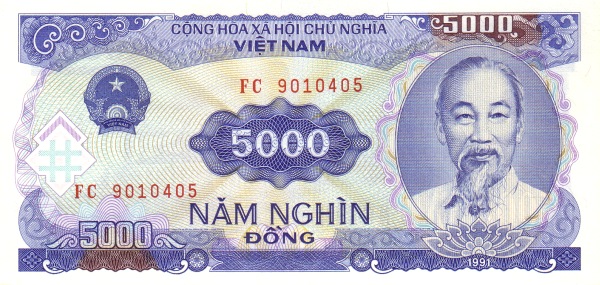Full experience of my visit to Hanoi can be accessed through the list below:
Attractions: St Joseph's Cathedral | One Pillar Pagoda | Ho Chi Minh Mausoleum | Thang Long Water Puppet Theater | Lý Thái Tổ Garden
Dining: New Day Restaurant | Sketch Coffee | Bánh Cuốn Gia Truyền | Dương Hoa Kem Caramen | Thu Nga Kem Xôi & Chè Thái Lan
More about Hanoi can be read through the list below:
Vietnamese Dong
When I first held my stacks of 100,000 Vietnamese Dong bills, I thought to myself, "I am a millionaire". I have 30 pieces of the notes (that's 3 million VND). For a short moment I started imagining myself as a rich man before my high spirited fantasy was broken by the realization that those 3 million VND was equivalent to only RM480, a far cry from a millionaire status. Oh well, at least I get to still validly claim that "I am a millionaire" even though it is not in RM.
My first experience of handling VND is one of confusion. The numerical is at such a high amount that it lulled me into a false sense of overspending. When I lowered my sense of alarm at overspending, a conversion at the end of the day would show that I did overspend on certain indulgences. Some food items were more expensive than back home, much as the souvenirs did.
 |
| VND10,000, with offshore platform on the reverse. The note is yellowish green in color (image from Banknote Museum). |
The Vietnamese Dong has VND1,000 as the lowest denominated bill, and anything lower than that is exchanged in coins. We did not encounter any of those coins in our recent trip to Hanoi though, a disappointment to the numismatist and collector in me, and wondered where they were. Prices were rounded to the highest VND1,000, so a VND10,500 item was sold as VND11,000. In this case, buying a pair would be a better deal.
I encountered two different materials as well as two distinctively different designs between the lower denominations, that of VND1,000, VND2,000 and VND5,000, and the rest of them. Researching online, it seems that the Vietnamese government decided to change the bills from paper to polymer in 2003. However this change was only applied on notes of VND10,000 and above, hence the difference in design.
Be it polymer or paper, all notes contained the well known figure of Ho Chi Minh, the national hero of Vietnam. Each note depicts a different design on the obverse, with the lower denominations (up to VND10,000) portraying industries supporting the economic life force of Vietnam while higher denominations show locales of Vietnam, mostly in the Northern and Central region.
I encountered two different materials as well as two distinctively different designs between the lower denominations, that of VND1,000, VND2,000 and VND5,000, and the rest of them. Researching online, it seems that the Vietnamese government decided to change the bills from paper to polymer in 2003. However this change was only applied on notes of VND10,000 and above, hence the difference in design.
Be it polymer or paper, all notes contained the well known figure of Ho Chi Minh, the national hero of Vietnam. Each note depicts a different design on the obverse, with the lower denominations (up to VND10,000) portraying industries supporting the economic life force of Vietnam while higher denominations show locales of Vietnam, mostly in the Northern and Central region.
 |
| The covered bridge of Hoi An, a town in Central Vietnam being designated as a UNESCO World Heritage Site, is depicted in the blue VND20,000 note (image from Banknote Museum). |
 |
| The city of Hue is depicted on the pink VND50,000 note (image from Banknote Museum). |
 |
| Văn Miếu, or the Temple of Literature, dominated the greenish yellow VND100,000 note (image from Banknote Museum). |
 |
| Halong Bay, itself a UNESCO World Heritage Site, is depicted on the reddish VND200,000 note (image from Banknote Museum). |
 |
| The highest valued Vietnamese bill, a cyan VND500,000, is dominated by Ho Chi Minh's birthplace in Kim Liên (image from Banknote Museum). |
How much do essentials cost in Hanoi compared to Malaysia? In general, spending on travel essentials in Hanoi is quite low, but they are surprisingly high for Malaysian standards. And no, we are not comparing against Kuala Lumpur prices, since that is obviously above Malaysian standard price.
A general comparison is listed below, with the cheaper one presented in blue, though more detailed comparisons could be obtained from my journal posts recording personal experience and thoughts on the recently concluded Hanoi trip from the link here - 2013 Hanoi Trip. The price here is only an average indication, and there could be places which charge lower price.
- black or milk coffee: VND20,000 (about RM3.20) versus RM1.50 (in coffee shops)
- noodles: VND45,000 (about RM7.20) versus RM4.00
- entrance fee: this is harder to compare since they vary greatly from each other; VND10,000 - 35,000 (about RM1.60 - 5.60) versus RM10 - 30 (more expensive for higher tech attractions)
- cab: another difficult comparison, so I compared required traveling time, which we usually spend 10 minutes for the a 5-seater cab to arrive at a destination; the Hanoi cabs which we took employed meters, whereas Malaysian cab fares are harder to gauge as most of them do not use meters; VND55,000 (about RM8.80) versus RM15
 |
| The VND1,000 note, the smallest Vietnamese note still being handled, depicts lumber production ((image from Banknote Museum). |
 |
| The VND2,000 note depicts the textile industry (image from Banknote Museum). |
 |
| The Trị An hydroelectric plant is immortalized in the VND5,000 note (image from Banknote Museum). |
Sources:









No comments:
Post a Comment